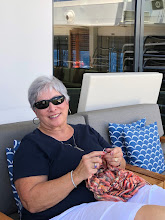 I learned all about wine today. My tour took us through the Medoc region of Bordeaux. I saw hour’s worth of vineyards and too many chateaus to count, plus lots of very old churches and villages, many from the 11th and 12th centuries. We stopped at Kirwin chateau for wine tasting and a tour of the facilities. To put it bluntly, the wine sucked. Even I, who am not a wine expert, knew this stuff was terrible. However, I did learn a few things about the French wine business.
I learned all about wine today. My tour took us through the Medoc region of Bordeaux. I saw hour’s worth of vineyards and too many chateaus to count, plus lots of very old churches and villages, many from the 11th and 12th centuries. We stopped at Kirwin chateau for wine tasting and a tour of the facilities. To put it bluntly, the wine sucked. Even I, who am not a wine expert, knew this stuff was terrible. However, I did learn a few things about the French wine business. The average size of an estate is 286,000 acres; 800 million bottles of wine are produced each year (90% is red); 33% of all wine is exported (Germany being the #1 destination); there are 12,000 wineries; 10,000 owners; 35 is the maximum number of wineries you are allowed to own; you need three things to make good wine – good soil, cooperation from mother nature, and a good winemaker; vines like sandy soil and no irrigation. AOC marked on a bottle guarantees it is from the Modoc region. Are you impressed? I could go on about the how and why of what I saw and learned today, but most likely you are just interested in the end product. Making wine is quite an art and takes a lot of time and skill.
We also toured the city of Bordeaux. There are many new parts of town, but it was the old parts that were interesting. It is a very old city, but outside of the central area most of it is relatively new (like the 17th and 18th centuries). There was not a lot of free time to explore the city on foot (that works for my feet). While on tour, our ship made the journey from Le Verdon up river to dock at the foot of the town. All the tour buses arrived at the dock at 8pm and the ship had not yet tied up when we arrived. There were hundreds of people on the promenade waiting to get on the ship, and everyone was hungry, too. Went to dinner in the dining room (the only place open to get food) and I ordered a P&J sandwich. My waiter felt that was not enough to eat, so he brought two sandwiches! I don’t know how people can eat such huge dinners so late at night (by this time it was close to 9:30pm).
Tomorrow more adventures in Bordeaux.
Michael’s turn:
Wow, what a great day! I escorted a seven hour excursion through the Medoc region of Bordeaux, hosted by a true expert. Dewey Markham, Jr. literally wrote the book, “1855: A History of the Bordeaux Classification,” which won the James Beard award for wine book of the year. He led us through extensive tours and tastings at two great wineries, and filled in the time between them with expert commentary on the region.
 I learned an awful lot about Bordeaux wines today. For example, they are all blended; they grow so well in this flat terrain because of the gravelly soil; and, Merlot is the most prominent grape although a lot of Cabernet Sauvignon is grown in the appellation areas (the most gravelly soil). Some Cabernet Franc is grown, but exclusively on the Right Banks so not strictly speaking in the Medoc region. We didn’t get to go in but we did drive by and take pictures of Chateau Lafite Rothschild. Chateau, by the way, means castle and “place where you grow wine,” and there are some 1,700 of these places in Bordeaux alone.
I learned an awful lot about Bordeaux wines today. For example, they are all blended; they grow so well in this flat terrain because of the gravelly soil; and, Merlot is the most prominent grape although a lot of Cabernet Sauvignon is grown in the appellation areas (the most gravelly soil). Some Cabernet Franc is grown, but exclusively on the Right Banks so not strictly speaking in the Medoc region. We didn’t get to go in but we did drive by and take pictures of Chateau Lafite Rothschild. Chateau, by the way, means castle and “place where you grow wine,” and there are some 1,700 of these places in Bordeaux alone. Our first stop was Chateau Lagrange, a Third Growth (that’s the classification system) winery producing some spectacular wines since 1855. Chateau Lagrange is in the Sainte Julian appellation. We tried their “hobby wine” first, a 2009 Sauvignon Blanc and is was non-descript. Their 2008 Bordeaux was good, but the 2002 Chateau wine was dreamy! We toured every aspect of this winery. Next, we went to Chateau Prieure Lichine, in the Margaux appellation. Again, we tasted a non-descript white, and two OK, but not spectacular Bordeaux wines, one a Chateau. From here we headed to Bordeaux to meet the ship.
Our first stop was Chateau Lagrange, a Third Growth (that’s the classification system) winery producing some spectacular wines since 1855. Chateau Lagrange is in the Sainte Julian appellation. We tried their “hobby wine” first, a 2009 Sauvignon Blanc and is was non-descript. Their 2008 Bordeaux was good, but the 2002 Chateau wine was dreamy! We toured every aspect of this winery. Next, we went to Chateau Prieure Lichine, in the Margaux appellation. Again, we tasted a non-descript white, and two OK, but not spectacular Bordeaux wines, one a Chateau. From here we headed to Bordeaux to meet the ship.
No comments:
Post a Comment